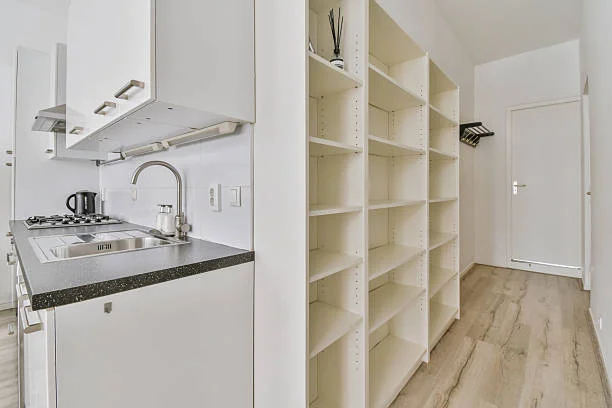Cheap storage furniture seems like a smart move until you’re replacing it every few years. When you invest in high quality cupboards with shelves, you’re not just buying furniture – you’re buying years of reliable service and fewer headaches down the road. The difference between budget and quality storage isn’t always obvious at first glance, but it shows up in ways that affect your daily life. Poor-quality cupboards develop sagging shelves, misaligned doors, and hardware failures that turn simple storage tasks into frustrating experiences. Quality pieces use better materials, more robust construction methods, and hardware that’s designed for thousands of open-close cycles. Studies from furniture industry associations show that well-made storage furniture can last 15-20 years with normal use, while budget alternatives typically need replacement every 3-5 years.
Construction Methods That Matter
The way shelves attach to the cabinet sides tells you everything about build quality. Cheap cupboards use simple wooden dowels or basic screws, which work fine initially but loosen over time as the wood expands and contracts with humidity changes.
Quality construction uses mechanical fasteners like cam locks or confirmat screws. These create stronger joints that can be retightened if needed. Even better are dadoes – grooves cut directly into the side panels where shelves sit. This distributes weight across the entire width of the panel instead of concentrating stress at a few screw points.
Back panels reveal another quality divide. Thin hardboard backs (usually 3-4mm) provide minimal structural support and can bow under load. Quality cupboards use at least 6mm plywood or MDF backs that actually contribute to the overall rigidity of the piece.
Corner joints are where cheap furniture really shows its weakness. Butt joints held together with screws will eventually fail. Dovetail joints, mortise and tenon, or even quality biscuit joints create connections that get stronger under load rather than weaker.
Stick around and explore more articles that might catch your interest!
Hardware That Handles Real Life
Drawer slides are probably the best indicator of overall quality. Basic roller slides cost about $3 per pair and feel rough within months. Ball-bearing slides cost $15-25 per pair but operate smoothly for years while supporting significantly more weight.
Full-extension slides let you access the entire drawer contents, which sounds minor until you’re digging around in the back of a shallow drawer trying to find something. The weight rating matters too – light-duty slides max out around 15kg, while heavy-duty options handle 45kg or more.
Hinge quality makes a huge difference in daily use. Basic hinges rely on friction to stay closed, which means doors gradually stop closing properly as the mechanism wears. Quality hinges use spring mechanisms or magnetic catches that maintain proper closure force throughout their lifespan.
Soft-close mechanisms aren’t just luxury features – they actually extend the life of both hinges and cabinet frames by eliminating the repeated impact stress of slamming doors. The mechanisms themselves can last 50,000+ cycles when properly manufactured.
Weight Capacity Engineering
Shelf loading limits aren’t just suggestions – exceeding them creates permanent damage that gets worse over time. Budget shelves often use 16mm or 18mm thick material, which starts sagging noticeably under 20kg loads when spanning 60cm or more.
Quality shelves use 25mm or thicker material, often with reinforced edges. Some high-end manufacturers add steel reinforcement bars underneath, hidden within the shelf thickness. Cupboards with Shelves lets them handle 40-50kg loads without visible deflection.
The shelf pin holes matter too. Cheaper cupboards drill standard 5mm holes that enlarge slightly with repeated adjustments. Quality pieces use reinforced inserts or brass sleeves that maintain tight tolerances even after multiple shelf repositions.
Long-Term Cost Analysis
Let’s run some actual numbers. A basic storage cupboard might cost $200 and last 4 years before needing replacement. Over 20 years, that’s $1,000 plus the hassle of shopping, assembling, and moving stuff multiple times.
A quality piece costing $600 that lasts 20 years saves money and eliminates the replacement headaches. But the real savings come from avoided frustration and wasted time dealing with malfunctioning hardware or unstable shelves.
Factor in the hidden costs of cheap furniture too. Wobbly shelves mean items fall and break. Misaligned doors that won’t close properly let dust accumulate inside. Sagging shelves make it harder to organize efficiently, leading to wasted space and repurchasing items you can’t find.
Adaptability for Changing Needs
Life changes, and your storage needs change with it. Kids grow up and need different types of storage. Work-from-home situations create new organizational requirements. Hobbies evolve and require different space configurations.
Quality cupboards often include modular components that can be reconfigured without buying entirely new pieces. Adjustable shelves are just the beginning – some systems let you add drawers, change door configurations, or even combine multiple units as your space grows.
Removable shelves and accessories cost more initially but provide flexibility that cheap built-in alternatives can’t match. Being able to take shelves out completely for cleaning or to accommodate oversized items is surprisingly useful.
Resale Value Considerations
Quality storage furniture holds its value remarkably well. Solid wood pieces from reputable manufacturers often sell for 60-70% of their original price even after several years of use. Designer pieces or limited production runs sometimes appreciate in value.
Budget furniture has essentially no resale value. The combination of wear, dated styling, and questionable structural integrity means most cheap cupboards end up in landfills rather than finding new homes.
Cupboards with Shelves matters even if you’re not planning to sell. Quality pieces remain attractive and functional longer, meaning you’re less likely to want to replace them for aesthetic reasons. That stability saves money and reduces the environmental impact of furniture turnover.
Want to learn more? Our other posts are just a click away!






